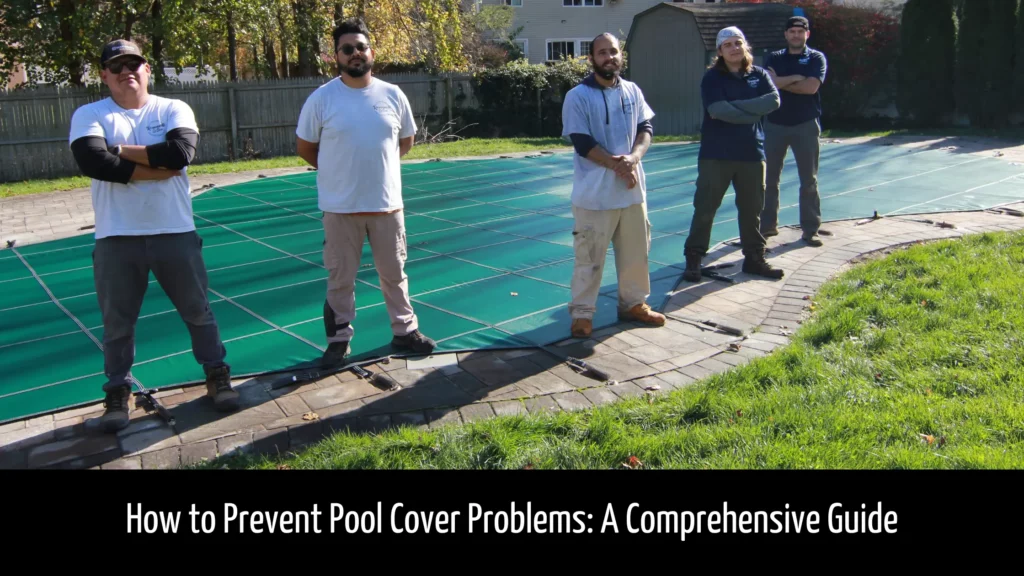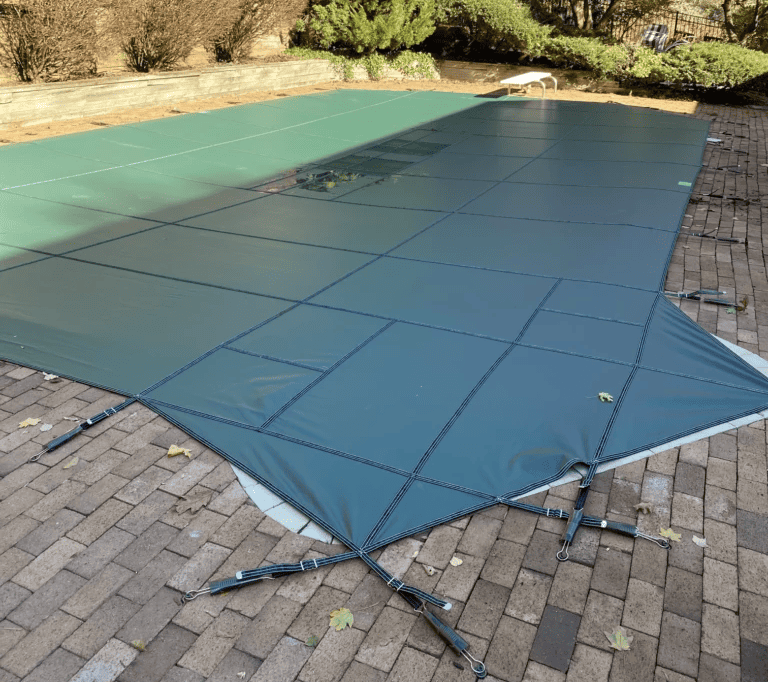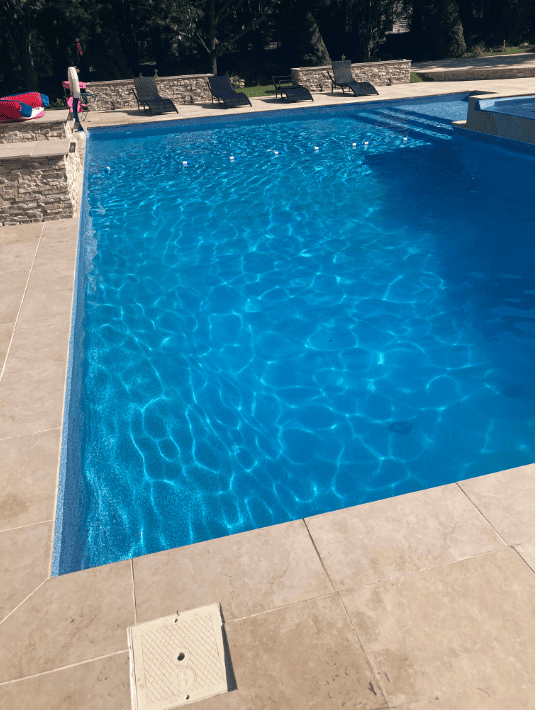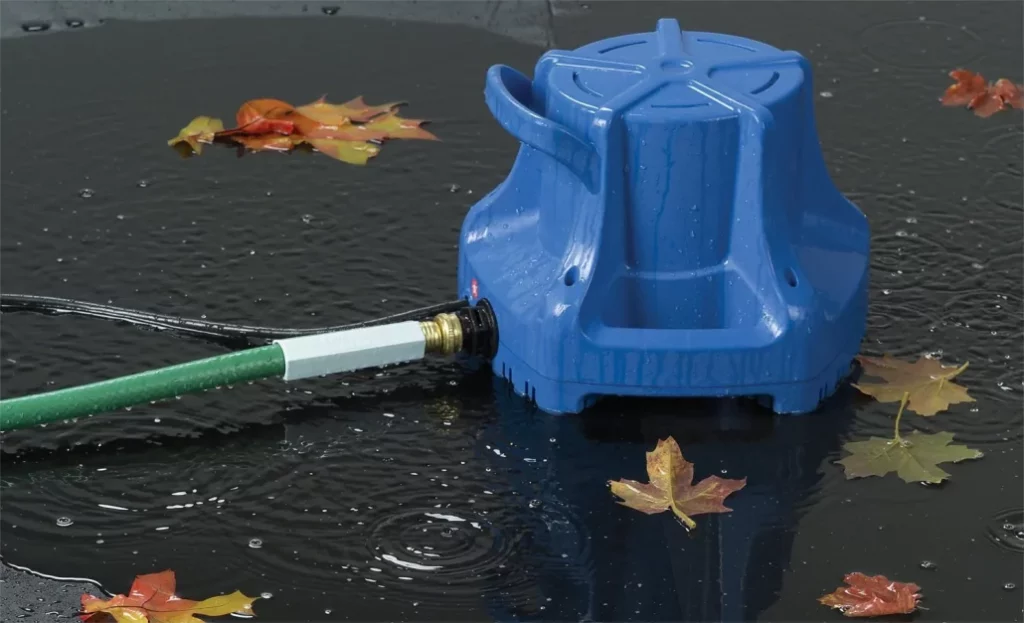Welcome to Romanelli & Son Pool Service, your trusted partner in pool maintenance and care. With years of experience serving the Long Island community, we understand the unique needs and challenges that come with pool ownership.

In this comprehensive guide, we’ll dive into a critical aspect of pool maintenance that often goes overlooked but is vital for the well-being of your pool – proper pool cover maintenance.
The Importance of Proper Pool Cover Maintenance
A pool cover is more than just a barrier that keeps leaves out; it plays a crucial role in preserving the integrity of your pool and ensuring its longevity.

At Romanelli & Son Pool Service, we firmly believe that an adequately maintained pool cover is an investment in the health and longevity of your pool.
Here’s why it matters:
Protection Against the Elements

Your pool cover acts as a shield, safeguarding your pool from leaves, debris, and harsh weather conditions. It prevents contamination, reducing the need for extensive cleaning and maintenance.
Safety
For families with children or pets, safety is paramount. A properly maintained safety cover can prevent accidents by providing a secure barrier over the pool.
Cost Savings
Regular maintenance and timely pool cover replacement can save you significant expenses in the long run. Neglecting cover care can lead to costly repairs and increased water and chemical usage.
In the following sections, we’ll explore every facet of preventing pool cover problems. We’ll provide practical tips, expert advice, and insights from our years of hands-on experience.
Whether you’re a seasoned pool owner or new to the world of pool care, you’ll find valuable information to help you protect your pool investment.
So, let’s dive in and learn how to select the right cover first.
Choosing the Right Pool Cover
Selecting the right pool cover is the foundation of effective pool cover maintenance. The type of cover you choose should align with your pool’s unique features and specific needs.
Let’s explore the various types of pool covers and why safety covers often emerge as the best choice for specific pool configurations.
Understanding Pool Cover Types
Safety Covers:
Safety covers are sturdy, mesh, or solid materials designed to bear weight and provide a secure barrier over the pool.
They are the top choice for families with children or pets. Mesh safety covers allow water to drain through, while solid safety covers prevent sunlight from reaching the pool water, reducing algae growth.
Solid Tarp Covers
Solid tarp covers effectively keep debris out of the pool and minimize water evaporation. However, they require a pool cover pump to remove accumulated rainwater and may not be suitable for pools with special features or small children and pets.
Matching Cover Type to Pool Features
When choosing a pool cover, it’s essential to consider your pool’s unique features:
Waterfalls

A safety cover is a wise choice if your pool boasts waterfalls or raised water features. Safety covers can be custom-fitted to accommodate these features while maintaining their integrity.
Raised Walls and Jagged Rock

Pools with raised walls or jagged rocks around the perimeter should also opt for safety covers. These covers are designed to withstand pressure and protect your pool in these challenging environments.
Simplicity vs. Safety
Solid tarp and mesh covers might be suitable for simpler pool designs but may not offer the safety and durability needed for more complex pools.
Safety covers are essential for pools with unique features.
Maintaining Your Pool Cover
Now that you’ve chosen the right pool cover for your specific needs, it’s time to dive into the essential topic of pool cover maintenance. Keeping your pool cover clean and debris-free is fundamental to its longevity and effectiveness.
Importance of a Clean Pool Cover
A clean pool cover is your first line of defense against elements. Here’s why it matters:
- Preventions of Debris Build-up: Leaves, twigs, dirt, and other debris can accumulate on your cover over time. If left unattended, this debris can create a haven for pests and promote mold and algae growth.
- Extended Lifespan: Regular cleaning and maintenance can significantly extend the lifespan of your pool cover, saving you the cost and hassle of premature replacement.
How to Maintain Your Pool Cover
- Brushing debris Off: To remove loose debris, gently brush the surface of your pool cover with a pool cover brush. Start from the middle and work towards the edges to avoid pushing debris into the pool. Be cautious not to use excessive force, especially on safety covers.
- Using a Leaf Net: A Leaf Net can be your best friend for larger debris like leaves. Place it on top of the cover and gently scoop up the debris. This prevents debris from sinking into the water when you remove the cover.
The Role of Automatic Cover Pumps

For those with solid tarp covers, dealing with accumulated rainwater is a common concern. Automatic cover pumps come to the rescue:
- Efficient Water Removal: These pumps are designed to automatically remove excess water from your pool cover, preventing it from sagging or tearing under the weight of accumulated water.
- Set it and Forget it: Automatic cover pumps are low-maintenance devices that operate as needed, ensuring your cover stays dry without constant manual intervention.
How Often Should You Perform Maintenance
The frequency of pool cover maintenance largely depends on climate and the presence of nearby trees.
Here are some general guidelines:
- Weekly inspection: During the swimming season, inspecting your cover weekly for any debris accumulation is a good practice. Remove debris promptly to prevent it from becoming a more significant issue.
- Regular Brushing: Light brushing to remove dust and small debris can be done as needed. Typically, once every few weeks is sufficient.
- Leaf Net Usage: Use a leaf net as necessary, especially when leaves are abundant in the fall.
- Automatic Cover Pump: If you have a solid cover, ensure your automatic cover pump functions correctly. It should activate as soon as it detects excess water.
Regular maintenance keeps your pool cover in top condition and reduces the risk of problems down the road. By following these simple steps and staying proactive, you can enjoy a clean and functional pool cover throughout the year.
Signs of Cover Wear and Tear
Your pool cover is a protective shield for your pool, but like any barrier, it can suffer wear and tear over time. This section will explore the telltale signs your pool cover may need attention.
Regular inspection is vital to catching these issues early and ensuring the continued effectiveness of your cover.
Common Signs of Cover Damage:

- Brittleness
One of the primary indicators of cover wear is brittleness. If your cover starts to feel stiff and inflexible, it’s a sign that the material may be deteriorating. This can be especially noticeable in safety covers.
- Tears and Rips
Visible tears, rips, or holes in the cover material are clear signs of damage. These openings can let debris and water through, undermining the cover’s purpose.
- Fading or Discoloration
Over time, exposure to sunlight and the elements can cause the cover material to fade or change color. While this may be more of an aesthetic concern, it can also indicate reduced durability.
The Importance of Regular Inspection
Regularly inspecting your pool cover is essential for several reasons:
- Timely Maintenance
Identifying damage early allows you to take action before the problem worsens. This can often mean less costly repairs and a longer cover lifespan.
- Preventing Further Damage
Addressing minor issues promptly can prevent them from escalating into significant problems that compromise the safety and functionality of your cover.
- Peace of Mind
Knowing that your pool cover is in good condition provides peace of mind, especially if you have children or pets.
When You Can See Through a Safety Cover
One critical point to remember is that safety covers should never be see-through.
If you can see the pool water or the ground below through your safety cover, it’s a sign of severe damage. Safety covers are designed to be solid and impenetrable, so any transparency indicates that the cover’s integrity has been compromised.
In such cases, it’s crucial to act swiftly. A damaged safety cover fails to provide the security it was designed for and can pose safety risks.
When to Replace Your Pool Cover
Knowing when to replace your pool cover is critical to responsible pool ownership. A well-timed replacement can save you from many problems, including increased maintenance costs and potential damage to your pool.
In this section, we’ll provide guidance on when to consider replacing your pool cover.
Factors to Consider
Several factors should weigh into your decision to replace a pool cover:
- Age: Pool covers, like all materials, have a finite lifespan. Even with proper maintenance, they will eventually wear out. The typical lifespan of a pool cover varies depending on the type and quality, but a safety cover may last around 10-15 years, while other types may need replacement sooner.
- Damage: Any visible damage, including tears, rips, or holes, should be a red flag. These openings compromise the cover’s ability to protect your pool from debris and can lead to costly issues.
- Wear and Tear: Covers that have become brittle, faded, or discolored have likely reached the end of their useful life. These signs of wear and tear indicate that the cover material is no longer providing optimal protection.
The Risks of Using an Old or Damaged Cover
Continuing to use an old or damaged pool cover comes with significant risks:
- Water Loss: A compromised cover can lead to water loss through evaporation. This means you’ll need to add more water to maintain proper pool levels, increasing your water bills and putting additional strain on your pool’s system.
- Increased Maintenance Costs: As a damaged cover allows debris into your pool, you’ll spend more time and money on cleaning and chemical treatments. Neglecting this can result in pool water imbalances and further expenses.
- Safety Concerns: Any damage or loss of integrity can pose a severe safety risk for safety covers. These covers are designed to support the weight of an adult, and if they can’t do so, accidents become more likely.
Additional Tips for Cover Care
In addition to choosing the right cover and knowing when it’s time for a replacement, several other essential aspects of pool cover care can help you maintain the longevity and functionality of your investment.
This section will provide valuable tips and insights on these critical areas.
Proper Storage When Not in Use
When the swimming season ends, storing your pool cover properly is crucial to protect it during the offseason.
Here’s how:
- Clean and Dry: Ensure the cover is thoroughly clean and dry before storing. Any moisture or debris left on the cover can lead to mold and mildew growth.
- Use a Cover Storage Bag: Invest in a cover storage bag designed to protect the cover from dust, UV rays, and pests. Proper storage bags are breathable to prevent mold and mildew.
- Store in a Cool, Dry Place: Find a cool, dry location to store your cover. Store your cover-up on a shelf to help prevent rodents and insects from nesting inside. Avoid exposure to direct sunlight, as this can cause material degradation over time.
Professional Pool Cover Inspections and Maintenance

While regular maintenance is essential, there’s no substitute for the expertise of a professional pool service company. Consider the benefits of professional pool cover inspections and maintenance services:
- Expert Assessment: Trained technicians can identify issues that may go unnoticed during routine inspections, ensuring early detection of potential problems.
- Repairs and Adjustments: If your cover requires repairs or adjustments, professionals have the knowledge and tools to perform them correctly.
- Peace of Mind: Professional maintenance provides peace of mind, knowing that your cover is in top condition and your pool is secure.
Seasonal Maintenance Routines:
To maintain your pool cover’s performance throughout the year, consider these seasonal maintenance routines:
- Spring: As the weather warms, remove the cover carefully, ensuring debris doesn’t fall into the pool. Clean and inspect it thoroughly before storage.
- Fall: Use a leaf net to catch falling leaves and debris. Keep the cover clean to prevent build-up.
- Winter: Ensure it’s securely in place to protect your pool from harsh weather and debris.
- Pre-Opening: Before opening your pool in spring, inspect and clean the cover again. Ensure all accumulated water is drained from the cover so it can be easily removed. Ensure it’s in good condition for the upcoming season.
By following these additional tips and considering professional maintenance, you can ensure that your pool cover continues to serve you effectively year after year.
Conclusion
In this comprehensive guide to preventing pool cover problems, we’ve journeyed through the vital aspects of pool cover care and maintenance.
Your pool cover is not just a protective barrier; it’s an investment in the longevity and health of your pool. Proper care and maintenance ensure that it continues to serve its purpose effectively, protecting your pool from debris, reducing energy costs, and providing a layer of safety for your loved ones.
At Romanelli & Son Pool Service, we are passionate about pool care and maintenance. If you have any questions or require expert assistance with your pool cover, don’t hesitate to reach out to us.
Our experienced professionals are here to help you keep your pool cover in optimal condition, ensuring years of enjoyment and peace of mind.



